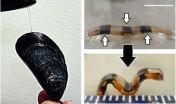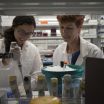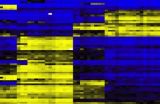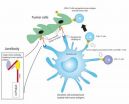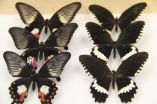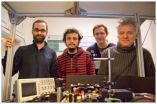(Press-News.org) COLUMBUS, Ohio – An enzyme that helps maintain immune system function by "throwing away" a specific protein has a vital role in controlling symptoms of allergic asthma, new research in mice suggests.
The finding suggests that this enzyme, called Cbl-b, could be a target for drugs used to treat allergic asthma and other autoimmune disorders.
This new study, led by Ohio State University researchers, is the first to link Cbl-b to allergic asthma in an animal model.
The findings parallel results from a 2012 Yale study in humans, which suggested that a mutation in the gene that produces Cbl-b was associated with higher risk for asthma in children. Other studies have suggested that inhibiting Cbl-b activity could reduce tumors and lower chances for cancer to spread.
Based on this assortment of findings, scientists believe Cbl-b could be manipulated in different ways depending on the disorder in question. Its activity could be elevated to keep excessive inflammation in check in people with allergic asthma, or it could be inhibited to treat cancer.
"We believe we have found one of the key molecules that can modulate the immune response," said Jian Zhang, associate professor of microbial infection and immunity at Ohio State and senior author of the study. "We can use this basic knowledge to try to find small molecules that can modify Cbl-b's function and use this to treat human diseases that include autoimmunity, asthma and tumors."
Allergic asthma is the most common form of asthma and is triggered by inhaling such allergens as dust mites, pet dander, pollen or mold, leading to inflamed and swollen airways of the lungs, according to the American Academy of Allergy Asthma & Immunology.
The Ohio State study is published in the current issue of the journal Cell Reports.
In this work, mice that are models for allergic asthma were injected with a substance that provoked an allergic response. Cells in the mice lacking the Cbl-b enzyme were unable to send a protein called Stat6 to a biological trash can once its services were no longer needed. With Stat6 active longer than necessary, two types of immune cells that it controls became overactive, eventually leading to excessive inflammation in the airways of these mice.
Mice with normal Cbl-b function had less severe allergic asthma symptoms.
Cbl-b is one of the key enzymes that participate in a process designed to keep protein levels stable in cells – in this case, cells that are present in the immune response. Cbl-b has the final step in the process, moving proteins whose job is finished to a space in the cell that functions as a garbage can, where they are degraded.
When the immune system is activated by a substance that generates an allergic response, cells called T cells are among the first responders. Once the invading substance is more clearly defined, a complex process transforms these general cells into different types of specialized T "helper" cells designed to fight specific invaders. Stat6 has a primary role in that T cell transformation.
Zhang and colleagues first determined in cell cultures that Cbl-b is needed in the general T cells to later control the activities of two types of T helper cells, called Th2 and Th9, involved in the allergic asthma response. But there is a step along the way that is critical to this process working properly: After Stat6 is activated by chemicals to help transform the T cells from general to specialized, Cbl-b must send the Stat6 protein to the garbage can.
If Stat6 is active for too long, it overstimulates Th2 and, to a lesser extent, Th9 cells so that they produce excessive inflammation in lung airways. Only Cbl-b can ensure that Stat6 doesn't overstay its welcome.
The researchers further confirmed Cbl-b's relationship to Stat6 in animal studies. In addition to observing that mice lacking Cbl-b became sicker than wild mice when exposed to allergens, Zhang deleted Stat6 from mice lacking Cbl-b to show that this protein, controlled by Cbl-b, was needed to push airway inflammation levels out of control.
"Without Stat6, Th2 was not active at all and Th9 was dramatically reduced. So we had minimal airway inflammation but not the abnormal, excessive inflammation present if Stat6 remains active. This suggests there is another factor involved in Th9 – we don't yet know what that factor is," Zhang said.
From here, Zhang and colleagues will investigate Cbl-b's potential role in the immune response to some infectious diseases. Zhang also hopes to collaborate with pharmacy experts to develop small molecules that could modify the enzyme's function.
INFORMATION:
This work was supported by the National Institutes of Health and the American Heart Association. Zhang also has been an American Lung Association Career Investigator.
Zhang began this work at the University of Chicago and completed it at Ohio State. Co-authors currently or formerly from the University of Chicago include Guilin Qiao, Haiyan Ying, Zhenping Li and Julian Solway, and Ohio State co-authors from microbial infection and immunity are Yixia Zhao, Yanran Liang, Hui Guo and Huifeng Shen. Additional co-authors are Enxiang Tao of Sun Yat-Sen University in Guangzhou, China; Y. Jeffrey Chiang and Stanley Lipkowitz of the National Cancer Institute; Josef Penninger of the Austrian Academy of Sciences; and Wallace Langdon of the University of Western Australia.
Contact: Jian Zhang, (614) 292-9447; Jian.Zhang@osumc.edu
Written by Emily Caldwell, (614) 292-8310; Caldwell.151@osu.edu
Researchers find potential target for drug to treat allergic asthma
Enzyme's role is to 'throw away' protein if it overstays its welcome during immune response
2014-03-05
ELSE PRESS RELEASES FROM THIS DATE:
Pumping iron: A hydrogel actuator with mussel tone
2014-03-05
Protein from a small, tasty mollusk inspired Michigan Technological University's Bruce P. Lee to invent a new type of hydrogel actuator.
Hydrogels are soft networks of polymers with high water content, like jello. Because of their soft, gentle texture, they have the potential to interact safely with living tissues and have applications in a number of medical areas, including tissue engineering. Lee, an assistant professor of biomedical engineering, wanted to make a hydrogel that wouldn't just sit there.
"Hydrogels that can change shape on command could be used to deliver ...
Going viral to target tumors
2014-03-05
March 5, 2014, New York, NY– A Ludwig Cancer Research study suggests that the clinical efficacy of checkpoint blockade, a powerful new strategy to harness the immune response to treat cancers, might be dramatically improved if combined with oncolytic virotherapy, an investigational intervention that employs viruses to destroy tumors.
Published today in the journal Science Translational Medicine, the study evaluated a combination therapy in which the Newcastle disease virus (NDV), a bird virus not ordinarily harmful to humans, is injected directly into one of two melanoma ...
Biomarkers of cell death in Alzheimer's reverse course after symptom onset
2014-03-05
Three promising biomarkers being studied to detect Alzheimer's disease in its early stages appear to undergo a surprising shift as patients develop symptoms of dementia, researchers at Washington University School of Medicine in St. Louis report.
Scientists use the biomarkers to assess brain changes linked to the disease in research volunteers. The levels of markers of neuronal injury increase in the spinal fluid for a decade or more before the onset of dementia, but in a new twist, the research shows for the first time that they later reverse course, decreasing as symptoms ...
An inventive new way to profile immune cells in blood
2014-03-05
ROVIDENCE, R.I. [Brown University] — When a person becomes sick or is exposed to an unwelcome substance, the body mobilizes specific proportions of different immune cells in the blood. Methods of discovering and detecting those profiles are therefore useful both clinically and in research. In a new paper in the journal Genome Biology, a team of scientists describes a new and uniquely advantageous way to detect them.
All the current means of counting immune cells in a blood sample require whole cells, said Karl Kelsey, professor of epidemiology at Brown and corresponding ...
Novel cancer vaccine holds promise against ovarian cancer, mesothelioma
2014-03-05
A novel approach to cancer immunotherapy – strategies designed to induce the immune system to attack cancer cells – may provide a new and cost-effective weapon against some of the most deadly tumors, including ovarian cancer and mesothelioma. Investigators from the Massachusetts General Hospital (MGH) Vaccine and Immunotherapy Center report in the Journal of Hematology & Oncology that a protein engineered to combine a molecule targeting a tumor-cell-surface antigen with another protein that stimulates several immune functions prolonged survival in animal models of both ...
Hungry for 'likes': Frequent Facebook use linked to eating disorder risk, study finds
2014-03-05
TALLAHASSEE, Fla. — Frequent Facebook users might be sharing more than party pictures, vacation videos and shameless selfies — they also share a greater risk of eating disorders, according to a new study led by Florida State University researchers.
Psychology Professor Pamela K. Keel studied 960 college women and found that more time on Facebook was associated with higher levels of disordered eating. Women who placed greater importance on receiving comments and "likes" on their status updates and were more likely to untag photos of themselves and compare their own photos ...
Prenatal nicotine exposure may lead to ADHD in future generations
2014-03-05
TALLAHASSEE, Fla. — Prenatal exposure to nicotine could manifest as attention deficit hyperactivity disorder in children born a generation later, according to a new study by Florida State University College of Medicine researchers.
Professors Pradeep G. Bhide and Jinmin Zhu have found evidence that ADHD associated with nicotine can be passed across generations. In other words, your child's ADHD might be an environmentally induced health condition inherited from your grandmother, who may have smoked cigarettes during pregnancy a long time ago. And the fact that you never ...
A single gene, doublesex, controls wing mimicry in butterflies
2014-03-05
A single gene regulates the complex wing patterns, colors and structures required for mimicry in swallowtail butterflies, report scientists from the University of Chicago, March 5 in Nature. Surprisingly, the gene described, doublesex, is already well-known for its critical role in sexual differentiation in insects.
"Conventional wisdom says that it should be multiple genes working together to control the whole wing pattern of a butterfly," said Marcus Kronforst, Neubauer Family Assistant Professor of Ecology & Evolution at the University of Chicago and senior author ...
Ultra sensitive detection of radio waves with lasers
2014-03-05
Radio waves are used for many measurements and applications, for example, in communication with mobile phones, MRI scans, scientific experiments and cosmic observations. But 'noise' in the detector of the measuring instrument limits how sensitive and precise the measurements can be. Now researchers at the Niels Bohr Institute have developed a new method where they can avoid noise by means of laser light and can therefore achieve extreme precision of measurements. The results are published in the prestigious scientific journal, Nature.
'Noise' in the detector of a measuring ...
Livestock can produce food that is better for the people and the planet
2014-03-05
With one in seven humans undernourished, and with the challenges of population growth and climate change, the need for efficient food production has never been greater. Eight strategies to cut the environmental and economic costs of keeping livestock, such as cows, goats and sheep, while boosting the quantity and quality of the food produced have been outlined by an international team of scientists.
The strategies to make ruminant - cud-chewing - livestock a more sustainable part of the food supply, led by academics at the University of Bristol's School of Veterinary ...
LAST 30 PRESS RELEASES:
Jeonbuk National University researchers explore the impact of different seasonings on the flavor perception of Doenjang soup
Two Keck Medicine of USC Hospitals named Leapfrog Top Teaching Hospitals
World-first discovery uncovers how glioblastoma tumours dodge chemotherapy, potentially opening the door to new treatments
A fatal mix-up: How certain gut bacteria drive multiple sclerosis
New AI tool identifies not just genetic mutations, but the diseases they may cause
Deep-learning model predicts how fruit flies form, cell by cell
Combination pills for high blood pressure may simplify treatment, improve long-term health
Immune system keeps mucosal fungi in check
Neurons within the brain use simple rules to localize genetic messages
Electrodes created using light
Second-hand gift-giving is a well-deliberated decision
How human interaction drove evolution to make bears less aggressive
National Poll: Few parents offer teens guidance on healthy eating during holiday season
Cannabis derivatives could provide new ovarian cancer treatments
Raising strong yeast as a petroleum substitute
Clues to the origin of hot Jupiters hidden in their orbits
Canada’s reduced pledge to Global Fund will impact domestic health
1 in 4 children with major traumatic injuries not cared for in pediatric trauma centres
Duke and Duke-NUS’ joint cross-population research to uncover "East-West" differences in disease and care
Scientists to ‘spy’ on cancer- immune cell interactions using quantum technology breakthrough
Tech savvy users have most digital concerns
Making lighter work of calculating fluid and heat flow
Normalizing blood sugar can halve heart attack risk
Lowering blood sugar cuts heart attack risk in people with prediabetes
Study links genetic variants to risk of blinding eye disease in premature infants
Non-opioid ‘pain sponge’ therapy halts cartilage degeneration and relieves chronic pain
AI can pick up cultural values by mimicking how kids learn
China’s ecological redlines offer fast track to 30 x 30 global conservation goal
Invisible indoor threats: emerging household contaminants and their growing risks to human health
Adding antibody treatment to chemo boosts outcomes for children with rare cancer
[Press-News.org] Researchers find potential target for drug to treat allergic asthmaEnzyme's role is to 'throw away' protein if it overstays its welcome during immune response
